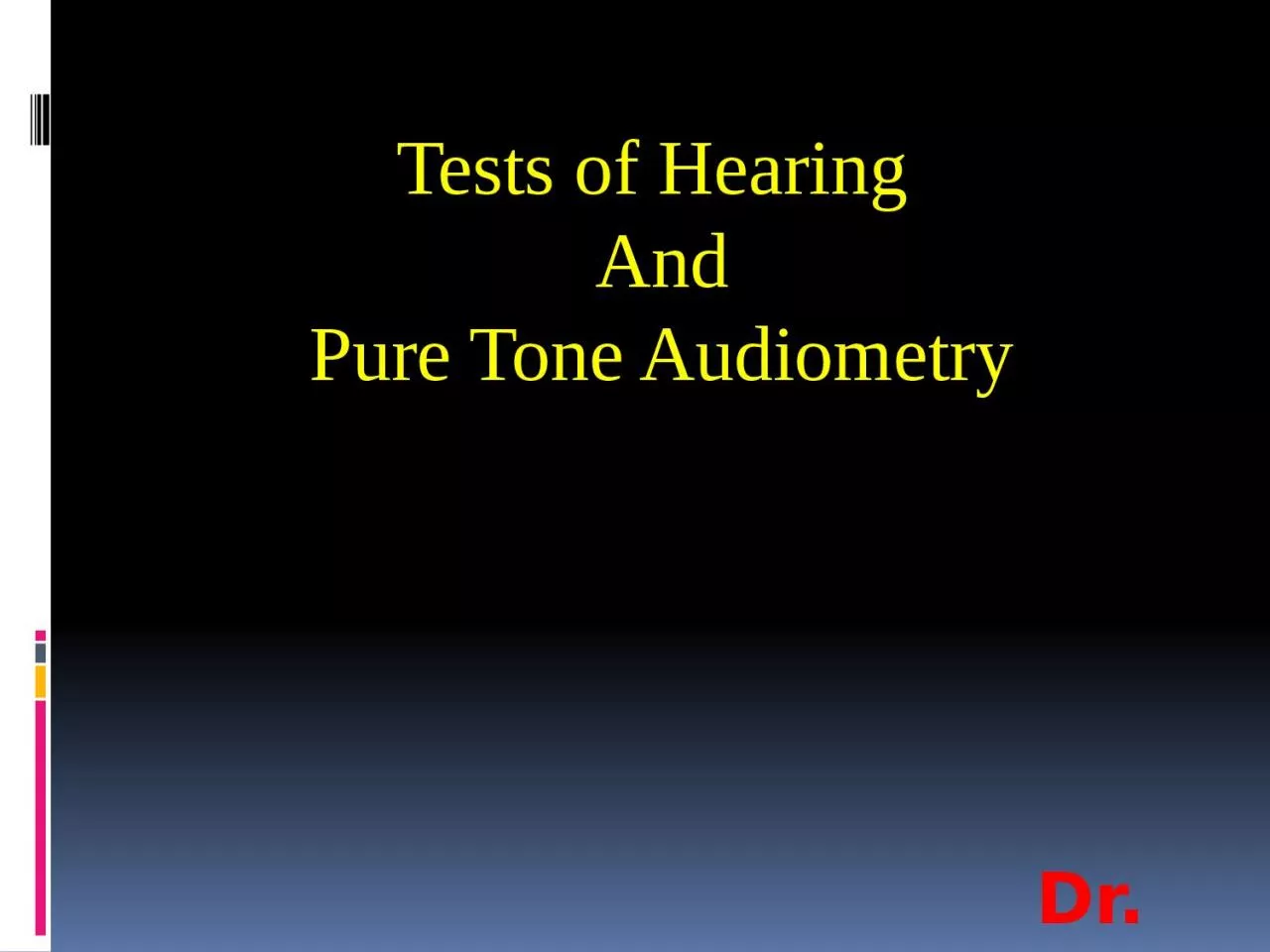

And Pure Tone Audiometry Objective The usual primary purpose of puretone tests is to determine the type degree and configuration of hearing loss To plot the frequency intensity recording and construct the audiograms ID: 1038558
Download Presentation The PPT/PDF document "Dr. Taj Tests of Hearing" is the property of its rightful owner. Permission is granted to download and print the materials on this web site for personal, non-commercial use only, and to display it on your personal computer provided you do not modify the materials and that you retain all copyright notices contained in the materials. By downloading content from our website, you accept the terms of this agreement.
1. Dr. TajTests of Hearing AndPure Tone Audiometry
2. Objective * The usual primary purpose of pure-tone tests is to determine the type, degree, and configuration of hearing loss. * To plot the frequency intensity recording and construct the audiograms * To interpret the audiograms
3. IN THIS PRACTICAL WE WILL DO:TUNNING FORK TESTSAUDIOMETRY
4. AIR CONDUCTION:This test assesses sensitivity when the signal is transmitted through the outer, middle, and inner ear and then through the brain to the cortex. Testing may be performed using headphones or insert earphones. TERMINALOGY
5. This technique assesses sensitivity when the signal is transmitted through the bones of the skull to the cochlea and then through the auditory pathways of the brain. This type of testing bypasses the outer and middle ear. BONE CONDUCTION
6. Masking presents a constant noise to the non-test ear to prevent crossover from the test ear. The purpose of masking is to prevent the non-test ear from detecting the signal (line busy), so only the test ear can respond. MASKING
7. A pure tone is a single frequency tone with no harmonic content (no overtones). This corresponds to a sine wave. PURE TONE
8. PURE TONE
9. AUDIOGRAM The audiogram is a chart of hearing sensitivity with frequency charted on the X- axis and intensity on the Y-axis. Frequency is the pitch of the sound measured in Hertz (Hz) and intensity is the volume of sound measured in Decibels (db).
10. AUDIOGRAM
11. TUNING FORK TESTS
12. RINNE’S TEST Technique First: Bone Conduction Vibrating Tuning Fork held on Mastoid processPatient covers opposite ear with hand Patient signals when sound ceases Move the vibrating tuning fork over the ear canal (Near, but not touching the ear) Next: Air Conduction Patient indicates when the sound ceases Normal: Air Conduction is better than Bone Conduction Air conduction usually persists twice as long as bone Referred to as "positive test" Abnormal: Bone conduction better than air conduction Suggests Conductive Hearing Loss. Referred to as "negative test"
13.
14.
15. WEBER TESTTechnique: Tuning Fork placed at midline forehead Normal: Sound radiates to both ears equally Abnormal: Sound lateralizes to one ear Ipsilateral Conductive Hearing Loss OR Contralateral Sensorineural Hearing Loss.
16.
17. PURE TONE AUDIOMETRYIn a sound proof room person is seated comfortably.Ear phones are applied which are color coded. (Red for right ear, blue for left ear.)Masking sound is delivered to the non-test ear.Start with a frequency of 125hz. & 0 db.Gradually increase the db. Till person hears the sound & respond.Mark the threshold intensity on the audiogram paper.
18. Cont…Find the threshold of hearing from 125 hz. To 8000hz. & Mark on the audiogram paper.Join the points to make air conduction audiogram.Place the bone vibrator over the mastoid process.Deliver the sound through the vibrator & find out the threshold of hearing for different frequencies of sound.
19. Cont…Use different sign to mark the bone conduction audiogram.Select the other ear and repeat the whole procedure.
20. TYPES OF HEARING LOSS Conductive hearing loss Sensorineural hearing loss Mixed hearing loss
21. Conductive Hearing loss (deafness)The abnormality reduces the effective intensity of the air-conducted signal reaching the cochlea, but it does not affect the bone-conducted signal that does not pass through the outer or middle ear. Examples of abnormalities include perforated tympanic membranes, fluid in the middle ear system, or scarring of the tympanic membrane. Pure-tone air-conduction thresholds are poorer than bone-conduction thresholds by more than 10 db
22. Conductive deafness
23. Sensorineural Hearing loss (deafness)This type of hearing loss is secondary to cochlear abnormality and/or abnormality of the auditory nerve or central auditory pathways. Because the outer ear and middle ear do not reduce the signal intensity of the air-conducted signal, both air- and bone-conducted signals are effective in stimulating the cochlea. Pure-tone air- and bone-conduction thresholds are within 10 dB.
24. Sensorineural
25. Mixed Hearing lossThis type of hearing loss has Sensorineural and conductive components. Pure-tone air-conduction thresholds are poorer than bone-conduction thresholds by more than 10 dB, and bone-conduction thresholds are less than 25 dB
26. Mixed Hearing Loss
27. DEGREES OF HEARING LOSS Normal hearing (0-25 dB) Mild hearing loss (26-40 dB)Moderate hearing loss (41-55 dB)Moderate-severe hearing loss (56-70 dB)Severe hearing loss (71-90 dB)Profound hearing loss (>90 dB)
28. COMMON AUDITORY DISORDERS Presbyacusis (age related hearing loss)Otitis media: This condition is marked by fluid in the middle ear space usually secondary to an infection.Noise-induced hearing loss. Otosclerosis: The condition is caused by stapedial fixation in the oval window, stiffening the middle ear system. Ménière disease
29. COMMON EXAMPLESConductive hearing lossSensorineural lossOtitis media PresbyacusisOtosclerosisNoise induced
30.
31. Presbyacusis
32.
33.
34. GlossaryPure toneDeafnessConductiveContralateralIpsilateralFrequency
35. THANK YOU